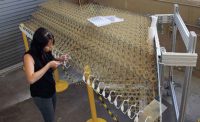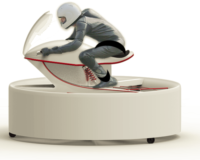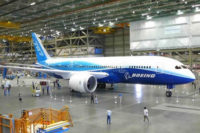Some birds, such as albatrosses and pelicans, skim over ocean waves and fly long distances—up to thousands of miles in a few days—without hardly flapping their wings. Using this dynamic soaring method, seabirds continually harness the power of air and wave currents to conserve energy as they glide along.
By flying low, the birds exploit the aerodynamic benefits of a phenomenon called ground effect. Flying close to water, wing downwash angles and tip vortices are suppressed, resulting in a major drag reduction and outstanding cruise efficiency.
Just like Orville and Wilbur Wright studied birds to unlock the secrets of wing warping 120 years ago, aerospace engineers today are also borrowing ideas from nature. They’re adapting ground effect and dynamic soaring principles to develop a new breed of aircraft that ride on top of a cushion of air to experience 70 percent less drag than a normal plane.
Ground effect is an aerodynamic principle that planes experience when flying close to the earth’s surface—either over solid surfaces or water. The phenomenon takes hold when operating within a distance of one wingspan from the surface.
Several startup companies are hoping to exploit wing-in-ground (WIG) effect aerodynamics with electric-powered aircraft for transporting passengers and freight.
In Europe, engineers at Elfly are working on a twin-engine seaplane that will ferry passengers and freight along the coast of Norway. Two electric motors with a maximum output of 825 kilowatts will provide a top speed of 300 kilometers per hour.
Closer to home, Boston-based Regent Craft Inc. is building a vehicle dubbed the “seaglider” that will fly five to 30 feet above the water and replace ferries and short-haul aircraft on coastal routes. When it enters commercial service in 2025, the half plane, half boat vehicle will operate as a ferry in congested waterways as well as a high-speed transport plane on open waters.
“[Our] all-electric flying machine combines the speed, comfort and navigation systems of an aircraft with the convenience, maneuverability and affordability of a boat,” says Billy Thalheimer, CEO, a former Boeing engineer. “It will be able to transport commercial passengers and critical cargo with a range of 180 miles at a speed of 180 mph leveraging existing dock infrastructure.
“Similar to a hovercraft, seagliders fly on a dynamic air cushion created by the pressurized air between the wings and the water,” explains Thalheimer. “The aerodynamic advantage of this so-called ‘ground effect,’ combined with operational efficiencies of always being a few feet away from a safe landing, give seagliders double the range of an electric aircraft.”
According to Thalheimer, aircraft operators are excited because the seaglider promises to be more cost-effective to operate, while ferry operators are intrigued because the vehicles will be six times faster than traditional ships.
Other entrepreneurs hope to harness WIG technology to provide fast, low-cost cargo delivery to coastal locations.
Engineers at Flying Ship Technologies Corp. are developing autonomous ground-effect vessels that will be 10 times faster than boats and 30 percent to 50 percent more energy efficient than traditional cargo airplanes.
“Our vessels will provide fast, inexpensive delivery of time-critical, price-sensitive goods,” says Gus Bateas, executive vice president and chief operating officer of Flying Ship Technologies Corp. “Initial variants will feature fully electric engines with a range of 500 nautical miles and a cargo capacity of 1,200 kilograms.”
Reliable, ergonomic solutions for wire harness assembly. These direct equivalents can be integrated into your assembly shop to deliver an easy-to-use, high power alternative using existing DMC dies and positioners. DMC also offers a line of accessories to support pneumatic tools including adjustable bench mounts, foot pedals, and air pumps.
“Our first full-scale vessel launch is anticipated in 2024,” notes Bateas. “We are currently testing systems on our second development vessel.
“A number of the systems we are using have not previously been used in the maritime environment,” claims Bateas. “These vessels require an equal balance of specialists from both the aerospace and maritime industries. We are integrating aerospace systems into platforms for use in the maritime environment, so using the knowledge base of both disciplines is critical.
“The initial variant will have a 41-foot wingspan, and about a 7,000-kilogram gross weight or displacement,” explains Bateas. “Lithium-ion batteries are likely to be used, though we are looking at alternatives.
“We will have four or more electric motors on the initial variant,” says Bateas. “For larger variants, we’ll be looking at a number of options. We are also assessing the materials to be used as we finalize the outer mold design.”
Flying Ship Technologies has not yet decided where its products will be assembled. “We have a multi-site strategy that is focused on the manufacturing and support requirements of regional customers,” Bateas points out. “We are evaluating multiple locations in the United States and overseas.”
According to Bateas, the biggest challenge to developing WIG vessels is on the regulatory side. “Safety is of critical importance, yet this is a new type of vessel for maritime operations, so there is no history with operating [it] in the current maritime environment,” he explains.
The International Maritime Organization (IMO) has established guidelines both for WIG vessels and autonomous operations, but the regulatory framework for this new class of craft has not yet been finalized.
The IMO defines WIGs as “craft supported in their main operational mode solely by aerodynamic forces which enable them to operate at low altitude above the sea surface, but out of direct contact with that surface. Accordingly, their arrangement, engineering characteristics, design, construction and operation have a high degree of commonality with those characteristics of aircraft. However, they operate with other waterborne craft and must necessarily utilize the same collision avoidance rules as conventional shipping.”






